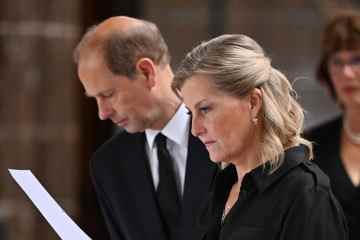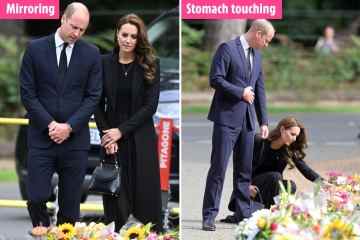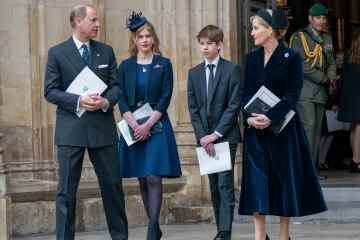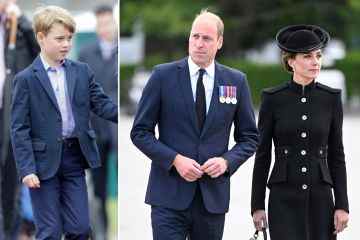GIVING his address at Westminster Hall, our new King Charles III recognised “the weight of history” upon him.
And the example of his mother provides him with much to admire.
The days of mourning we have witnessed prove that he rules a nation deeply proud of their previous monarch, a woman of substance who touched hearts across the world.
Her Majesty’s size four shoes will be hard enough to fill as it is.
But the odds of King Charles ranking among our greatest monarchs are further stacked against him for the simple reason: He is not a woman.
The three rulers that Britain has dubbed its finest were: His mother, Victoria and the first Elizabeth.


One virgin queen, one grieving widow, one faithful wife.
Obviously, the longevity of each reign was a factor.
Elizabeth II, reaching her Platinum Jubilee, eclipsed Victoria’s record of 63 years, seven months and two days, while Elizabeth I’s mere 44 years is some way down the list.
But they each provided continuity during periods of immense change.
Elizabeth I presided over a golden age of literature — think Shakespeare and Marlowe — and the defeat of the Spanish Armada (though the wind and waves had more to do with it than she).
She settled the Church of England into a moderate form of Protestantism that Puritans and Catholics equally hated but could mostly stomach.
On her watch, Martin Frobisher and Humphrey Gilbert set out to discover the Northwest Passage — the seaway linking the Atlantic and Pacific Oceans — and explore the Americas.
AGE OF INVENTIONS
Economic prosperity followed, from the liberation of Spanish treasure and expanding trade.
And she did not pursue the historical dead-end of lost lands in France, as her father, Henry VIII, had done.
Victoria’s was an age of prosperity, innovation and of inventions — the bicycle, the telegraph, the anaes- thetic, the internal combustion engine.
There were advances in workers’ welfare and education, and the extension of voting rights.
Above all, she presided over the massive expansion of the British Empire.
Over the 19th Century, the empire grew by 10million square miles and 400million people.
By the time of her death in 1901, it covered a fifth of the Earth’s surface. Once, this was thought a good thing.
By contrast, the reign of our late Queen was a time of decolonisation.
The British welfare system and NHS were in their infancy.
Over her 70 years, Britain joined and left Europe; our society became multicultural; feminism made inroads; and homosexuality was decriminalised.
Enormous advances were made in science, technology and medicine — Her Majesty came to the throne before the space age and endured into the digital age.
All three women came to the throne by chance.
Elizabeth I would not have acceded to the throne in 1558 had Katherine of Aragon’s son by Henry VIII survived, had Henry not reinserted his daughter into the line of succession before his death, had her younger half-brother and elder half-sister not died childless.
Elizabeth II, meanwhile, only came to the throne because, famously, her uncle, Edward VIII, abdicated to marry the twice-divorced Wallis Simpson.
His brother Albert reluctantly acceded as King George VI, making his eldest daughter, Lilibet, next in line.
Victoria’s journey to the throne was even more improbable. At her birth in May 1819, she was fifth in line.
Had her mother fallen pregnant again with a son, he would have trumped her.
But her father, Edward, Duke of Kent, died eight months after her birth.
Six days later, his father, George III, also died.
When George IV came to the throne in 1820, he was estranged from his wife, Caroline of Brunswick, and their only child, Princess Charlotte, had died.
That led to competition among Victoria’s uncles — few of whom were in officially recognised marriages — to produce an heir.
The eldest, Frederick, died within seven years. By George IV’s death, only William IV was left.
At 64, he became the oldest new king in British history before our present monarch.
He had no heir because all his surviving eight children were illegitimate. On his death, Victoria became queen.
Each queen was met by a wave of enthusiasm: All were young — Victoria was 18 and both Elizabeths 25 years old.
As women in the patriarchal 1550s, 1830s and 1950s, they were all underestimated — but expectations set low can easily be surpassed.
Elizabeth I used it to her advantage. She described herself to the House of Commons as “being a woman, wanting both wit and memory”.
And she later boasted that though she had the body “of a weak and feeble woman”, she had “the heart and stomach of a king, and a king of England too!”
Elizabeth I, as the historian Christopher Haigh wrote, founded her reign on two illusions: That she had taken over after a period of chaos and instability, and that she brought harmony.
In the eyes of contemporary writers like the martyrologist John Foxe, the fact that she was not a Catholic and married to a foreigner, as her half-sister Mary had been, counted for a lot.
Victoria, too, was the antithesis of what had come before — George IV and his wicked brothers.
George’s obituary in The Times in July 1830 said, “There never was an individual less regretted by his fellow creatures”, and defied its readers to find a single tear to shed for him.
The queens shared the quality of being relatively tolerant in religion, taking counsel and not pressing too heavily for reforms to the status of women (Victoria had no sympathy for suffragettes).
Despite her prolonged mourning after Albert’s death, Victoria worked right up until the end of her life, as she had during her pregnancies.
While Elizabeth II returned to public duty four days after the death of the Duke of Edinburgh, Victoria remained secluded for many years after Albert had passed.
HARDNESS OF HART
That the late Queen met the new PM two days before her own death epitomises her selfless commitment to duty, a visceral reaction to her abdicating uncle’s dereliction of responsibility.
In contrast to Elizabeth II’s compassion, modesty, discretion and forbearance, Elizabeth I and Victoria’s success was sometimes despite themselves.
The first Elizabeth was violent and bad-tempered — she stabbed a waiting-woman in the hand for clumsiness in serving her at table — and her mood was a daily part of court life that had to be negotiated.
She was also frustratingly indecisive, giving what her chief secretary William Cecil described as “answers answerless”.
That she did not marry was turned into a PR triumph, but it seemed disastrous at the time, almost fatally selfish about the future of the country.
And it created a political and emotional climate at court that forced her courtiers to play at being her suitors in order to achieve any political ends.
It also meant that good-looking men without political office — such as Sir Walter Raleigh — could advise the queen on foreign policy.
Victoria was a complicated mix.
Her biographer Elizabeth Longford describes her as “both unselfish and inconsiderate, tactful and blunt, sympathetic and hard, patient and fidgety, direct and devious”.
She did not have the personal charm of Elizabeth II.
Her chief enduring quality was stubbornness, learnt from having to defy her mother’s constraints.
But the sycophancy of her childhood led to arrogance and a hardness of heart.
When more than a million Irish people starved to death in the Great Potato Famine, Victoria’s response to restiveness was that they should be “crushed”.
After Prince Albert’s death, her retreat into mourning removed her from the political sphere.
Happily, this meant that after the Reform Act of 1867, as power shifted to Parliament, Victoria did not try stop it.
In fact, the historian Jane Ridley argues that Victoria’s “popularity grew as her power shrank”.
Even though she was never seen in public, her miserabilist narrative — she said of herself after Albert’s death, “the poor fatherless baby of eight months is now the utterly broken-hearted and crushed widow of 42” — endeared her to mawkish Victorian society.
All relied heavily on the men in their lives. Elizabeth I’s secretary Cecil (later known as Lord Burghley) worked tirelessly at her side for 40 years, managing all state business, both foreign and domestic.
Through the immense spy network he built, he knew everything, and he was highly effective.
In his last letter to his son Robert, he advised him to “serve God by serving of the Queen, for all other service is indeed bondage to the Devil”.
Victoria idolised and detested in turn: PM Benjamin Disraeli was good, whereas PM William Gladstone bad.
Prince Albert had been the real political mover, but when he died, she clung to sole power, refusing to allow her son, Bertie, Prince of Wales, access to state papers.
She blamed him for Albert’s death (the couple had been shocked to learn that their son had consorted with a prostitute in Ireland).
What she did allow Bertie to be, while she hid away, was the de-facto head of London society.
As such, he became her lightning rod and scapegoat.
For the late Queen, the Duke of Edinburgh was always, as she said, “her strength and her stay”.
We have inherited the idea that Elizabeth I and Victoria were great.
But at the time of Elizabeth I’s death in 1603, as Bishop Goodman later commented: “The people were generally very weary of an old woman’s government.”
It was when the following Stuart kings proved so disappointing that men looked back to Elizabeth as the paragon of all virtues.
For Victorians, the reflection of their own queen in Elizabeth I meant that they stressed her role in the foundation of the empire: Elizabeth’s story became the story of Raleigh and Drake.
What went less observed was how the Queen’s man, Captain John Hawkins, became, in 1562, the first known Englishman to include enslaved Africans in his cargo.
Victoria’s reign has been characterised as an age of industrial expansion, economic progress and peace.
But the illusion of Pax Britannica — the 99-year period of relative peace in Europe between the Napoleonic Wars and the outbreak of the World War One — disguises the fact that Victorian Britain was nearly continually at war, just not on home soil.
The Crimean War — think of the Charge of the Light Brigade — was immensely popular, while the expansion of Britain’s empire meant near continual, bloody warfare.
TORTURE CAMPS
Putting down a rising in Jamaica in 1865, the governor Edward Eyre said “the retribution had been so prompt and so terrible that it is likely never to be forgotten”.
Enrichment of the mother country involved brutal subjugation of colonial subjects.
Victoria was declared Empress of India in 1877 — a title she loved — after severe reprisals following the Indian War of Independence of 1857, including blowing rebels from cannons.
We now know that the violence of empire continued into Elizabeth II’s reign — horrific torture camps were used, for example, against the Mau Mau in Kenya in the 1950s.
With a strange understanding of what constitutional monarchy means, some American commentators seem to consider her an international war criminal because of such brutal actions by the British government in Africa.
However, there is no evidence that the Queen knew about the violence. She certainly would not have approved.
What was important to her, and what she was largely responsible for, was the Commonwealth, which seeks to amplify the voice of poorer nations.
The Commonwealth led the condemnation of racial discrimination in the 1960s and 1970s in the Singapore Declaration of Commonwealth Principles, and it campaigned for debt relief for developing countries in the 1980s and 1990s.
In Elizabeth II, we really did have a great queen — a queen who could not change policies but could change minds.
Her authority, humour, professionalism and discretion, combined with a warm heart and a steely nerve, were the keys to her success.


Of all our queens, she may have had the least constitutional, but the most personal power.
Having watched her in action for so long, that’s undoubtedly some-thing the King already knows.







